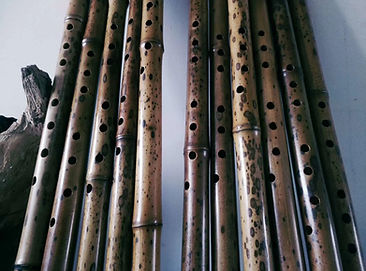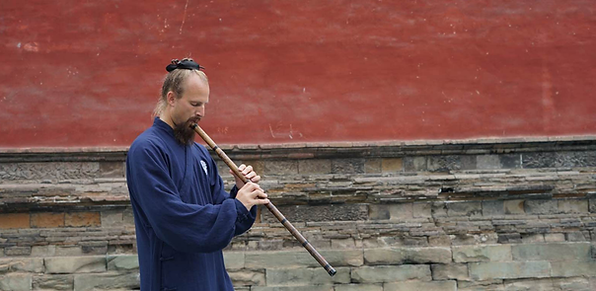top of page

Xiao Instruction
Introduction to the Xiao
The Chinese Vertical Bamboo flute, pinyin name Xiao (箫), is one of the most ancient and versatile instruments in Chinese history. While the history of the Xiao can be dated at roughly 8,000 years, the version that is common in modern times was slowly honed into style 1500 - 2000 years ago. There is a wealth of history of different wind instruments in China. The term "xiao" originally was meant for a pan pipe type instrument which was a series a pipes of different lengths tied together with each making a different tone when played. This type of instrument has its cultural reincarnation in many cultures but it doesn't have the versatility of the modern xiao. Even in the beginning, the oldest versions were made from many different materials. Some of the oldest versions are made from bone, horn, wood, jade, porcelain, ivory, and metal. It was discovered that the best material that offered the most peaceful tone came to be bamboo. Specifically "purple bamboo" was the strand that offered the most uniform and clear sound. Even as the material was specified the number of holes also came to be defined. In the beginning, there were numerous variations on hole placement, number, and size. This slowly became standardized in the Jin Dynasty. Although, even then 6 holes was more typical. Eight holes slowly became the standard, not because it brought more range into the instrument, but rather because it simplified the playing and fingering patterns. With 8 holes for finger placement, notes are easier to play as well as half notes, flats, and sharps easier to arrange in musical pieces. The flutes also have 2-6 sound holes towards the end of the flute to promote a warm tone and amplify sound as it leaves the bamboo.
Being of such simple construction and easy to travel with, they became iconic of travelers. Especially for merchants that moved along the Silk Road. This is where the versatility of such a flute came to be known. Unlike other flutes and woodwinds, the xiao does not have a mouthpiece that is covered and blown in to. Rather one bamboo end is open and blown into much like one would blow in to a jug to create sound. This allows the musician to alter the sound based on his or her breath control. By blowing wider and higher, one creates a lower pitch.

Conversely, if one blows more narrow and downward, a higher pitch is created. By doing this, and combining such techniques with finger patterns, the musician is able to have a musical range through 3 octaves. This allows for a wide promotion of music as the xiao can emulate almost any other flute and can accompany or replace many others as a substitute. If a merchant wanted to share his cultural songs and pick up a few from others along his way down the Silk Road, he would be quite the tavern friendly with a xiao in hand.

The construction of the xiao even has more varieties and unique qualities. There are 4 distinct varieties based on their overall construction, the dongxiao (standard, short and fat), the qinxiao (a more narrow version), the beixiao (light tone and longer bamboo), and the nanxiao (open mouthpiece, short and wide construction). Then, there are 3 main types of the vertical flute that we will typically discover in their solid construction.
There are flutes that have been designed from the very base of the bamboo plant, including the start of the root structure. There are only one of these flutes made from each bamboo stalk and the tone and quality of bamboo is often the most sought for and therefore may be more expensive with the right craftsman behind the work. There are solid construction flutes that are made from one continuous piece of bamboo but lacking the root structure at the bottom. There are multiple of these made from each stalk and they are generally your moderately priced and quality flutes. Lastly, there are flute that are made with multiple pieces of bamboo and connected together with metal ends. These are more modern in design and offer an even more convenient way to travel. These flutes have the potential to be either worse or much better, again dependent on the craftsman behind the work. This is because the bamboo that is fitted together does not necessarily have to be from the same stalk of bamboo. This can either alter the tone making it less uniform because it was made of the short, leftover, end pieces of the stalk or it could enhance the tone because it was made of a combination of the better pieces. Either way, this type of flute offers the most unique and efficient construction, especially when it comes to travel.
Other features of a xiao include the ornamentation on the flute itself and the wrappings that are commonly found near the joints of the bamboo. These wrappings help to assist and to protect the flute from damage caused by the natural flex and warping of the bamboo in different temperatures and humidity levels. Towards the end of the flute you may also find ornamentation hanging from the sound holes at the back end of the flute. This has no effect on the tone itself, but it is just the last part of a musicians ability to customize their own flute.

The warm, peaceful tone of the xiao has been referenced in classical Chinese way as being the King of all Flutes as the sound that emits from a well practiced xiao musician is akin to the voice of the legendary phoenix itself. Jumping from low to high melodies, the xiao is a instrument that can carry one through a series of emotions and soothes the souls of weary travelers. You may find the xiao in intimate and ceremonial events along with the guqin (the Chinese 7 stringed zither), or accompanied by the guzheng (the Chinese 21 string zither, an instrument with a more harp like quality to it) in a more upbeat and orchestrated setting. Learning the xiao is a great way to experience for yourself the simple, yet unbounded capabilities of such a natural instrument.
Self-Study Online through the Ways
I am proud to offer you access to free online resources to get started with learning how to play the xiao. I have been inspired by this simple piece of bamboo and I have found music in my life once again. I am happy to be able to share what I have learned and hopefully clarify details that escaped my understanding when I was starting off. It is my hope that through Wudao Music you can bring not only light to your practice but also music to your Spirit! These study materials will bring you step by step through everything you need to know to read and play great music with the xiao!
Here is a list of the resources currently available, all for free! Click through to get started now!
-Huge Collection of Song Notation
(organized by difficulty levels, Beginner, Intermediate, and Advanced)
-Play Along Practice Video Playlists (Available for both G key and F key xiao)

find your balance,
one breath at a time
Sign Up For Private Lessons Online
To get more out of the learning process, private online lessons are also available. Send an email to waysofwudang@gmail.com and set up a time for your first class. Classes are available through Zoom, Skype, or Discord.

Get Started Today!
Anchor 1
Anchor 2
Anchor 3
bottom of page